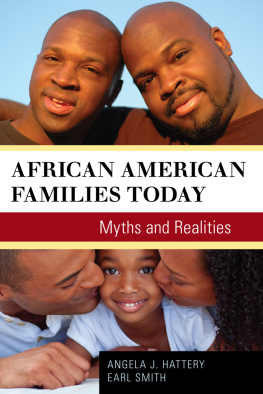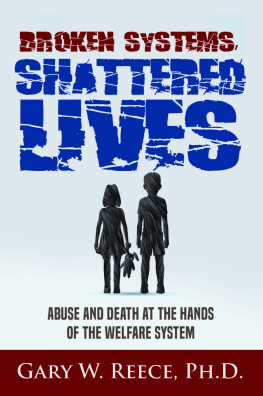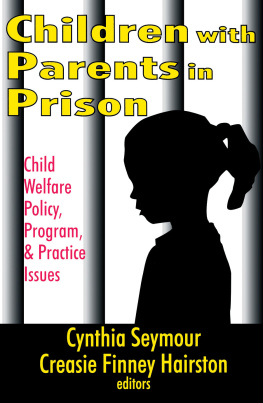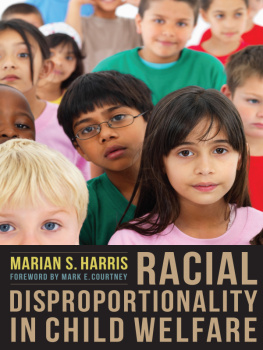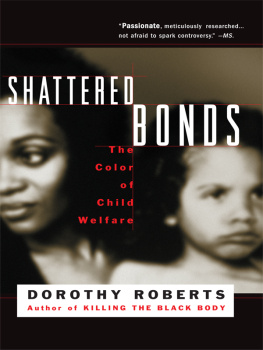Columbia University Press
Publishers Since 1893
New York Chichester, West Sussex
cup.columbia.edu
Copyright 2013 Columbia University Press
All rights reserved
E-ISBN 978-0-231-53620-2 (e-book)
Library of Congress Cataloging-in-Publication Data
Denby, Ramona W.
African American children and families in child welfare : cultural adaptation of services / Ramona W. Denby and Carla M. Curtis.
pages cm
Includes bibliographical references and index.
ISBN 978-0-231-13184-1 (cloth : alk. paper)
ISBN 978-0-231-13185-8 (pbk. : alk. paper)
ISBN 978-0-231-53620-2 (e-book)
1. Social work with African American children. 2. Social work with African Americans. 3. Child welfareUnited States. I. Curtis, Carla M. II. Title.
HV3181.D46 2013
362.77896073dc23
2013013777
COVER IMAGE: Romare Bearden, Sunday After Sermon (1969). Museo Thyssen-Bornemisza/Scala/Art Resource, NY. Romare Bearden Foundation/Licensed by VAGA, New York, NY
COVER DESIGN: Milenda Nan Ok Lee
A Columbia University Press E-book.
CUP would be pleased to hear about your reading experience with this e-book at .
References to Web sites (URLs) were accurate at the time of writing. Neither the authors nor Columbia University Press is responsible for URLs that may have expired or changed since the manuscript was prepared.
The purpose of this book is to inform an approach to child welfare service delivery to African American children and families that is based on cultural adaptation as the mediating construct with the existing system of care. This approach requires identification of the current systems limitations in meeting the needs of African American children and their families, and then using the needs and conditions of families to propose policy and program responses that make requisite cultural adaptations targeted to this population. The disparate experience of African American children and youths in the out-of-home child welfare system provides the primary rationale for considering an alternative approach to the study of child welfare.
The primary objective is to describe how cultural adaptations can be used in the delivery of child welfare services to African American children and families. To accomplish the objective, the book entails a review and evaluation of the three major child welfare goals: (1) protection; (2) permanency; and (3) well-being. Specifically, we explore the effect of these three goals on African American children and families. An important feature of the book is the recommendations for policy, practice, and research that can guide intervention with this population.
USING THE BOOK
The book is intended for use by people who have a basic knowledge of systems of care, human behavior theories, and social work practice skills. The practitioners who use it may be enrolled in a graduate program in social work or a graduate course of study, or be a participant in training directed to government bureaucrats, administrators, or program managers concerned with improving the child welfare service delivery system. Emphasis is placed on knowledge building, policy analysis, and research to improve the strategies and skill sets used when working with African American children and families.
The book will be useful for child welfare professionals (practitioners and administrators), students, grassroots organizers and policy advocates, researchers, and instructors. With its hallmark feature, the cultural adaptation approach, it provides readers with an explication of basic skills, steps, and strategies that are useful in the delivery of child welfare services to African American children and families. The book integrates practice, policy, and research and includes study tools and resources (a , discussion questions, and activities for ongoing learning); thus it can be easily incorporated into such courses as child welfare, family practice, social work and the law, social work practice, cultural diversity, policy, child welfare integrative seminar, and special topic electives. Following are recommendations for how readers can make best use of the book.
Students
We recommend that students begin by reading each chapter thoroughly. Some students might find it helpful to use the and can use the components contained in that chapter as headings and subheadings to structure the paper. Students may also consider using the book as a study tool to prepare for graduate comprehensive or qualifying examinations, given the fact that it includes detailed discussion of the three major child welfare components: protection, permanency, and well-being.
Child Welfare Professionals
can be culturally adapted so that they are more effective with African American children and families. After reading these chapters in particular, some child welfare professionals may be prompted to engage in a critical analysis of the approaches that are currently being used in their local child welfare systems. Some may find that they can use the recommended approaches in their day-to-day interactions with clients.
Grassroots Organizers and Policy Advocates
Advocates will find the conceptual framework () compelling and useful for data mining as they prepare arguments for system reform. Several empirical studies, national analyses, and government reports have been synthesized and are presented throughout the book, especially in the first three chapters. Policy advocates will find a plethora of facts and figures they can use to educate and inform decision makers.
Researchers
A research direction and several research ideas are presented in . Using the cultural adaptation framework, researchers are presented with a strategy for evaluating the adequacy of evidence-based interventions. Additionally, researchers can incorporate some of the suggested advocacy-based research strategies into their own work. Finally, some may be motivated to develop pilot studies or seek funding for demonstration sites that test the proposed performance-based research approach.
Instructors
Instructors can use this book in multiple ways: First, as required reading for undergraduate and graduate students, instructors can use the chapters and the related discussion questions as lecture topics or in group or class discussions. Second, instructors can use the recommended projects and assignments as tools to increase students comprehension of class and book content. Third, although the entire book is useful for all students, instructors will find that the first three chapters are especially provide excellent food for thought for advanced students as they prepare major papers.
In short, whatever the status of the reader, this book is best used as a tool for challenging ones critical thinking skills and expanding ideas about the possibilities for reforming a child welfare system that remains inadequate to address the needs of African American children and families. The book can be used as both an academic textbook and a professional training tool.
OVERVIEW OF CHAPTERS
Each chapter is formatted so that readers can make easy reference to research citations. A of terms is provided at the end of the book to facilitate the use of the book as a practical tool in the workplace or the classroom.



